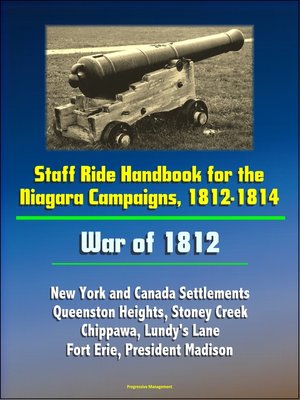Staff Ride Handbook for the Niagara Campaigns, 1812-1814
ebook ∣ War of 1812--New York and Canada Settlements, Queenston Heights, Stoney Creek, Chippawa, Lundy's Lane, Fort Erie, President Madison

Sign up to save your library
With an OverDrive account, you can save your favorite libraries for at-a-glance information about availability. Find out more about OverDrive accounts.
Find this title in Libby, the library reading app by OverDrive.



Search for a digital library with this title
Title found at these libraries:
| Library Name | Distance |
|---|---|
| Loading... |
Professionally converted for accurate flowing-text e-book format reproduction, this staff ride handbook covers the War of 1812 in the Niagara region. Subjects covered include: Stephen van Rensselaer, Henry Dearborn, Winfield Scott, Jacob Brown, Gordon Drummond, Red Jacket.Between 1812 and 1814, the US Army fought a series of actions centered on the thirty-seven mile river boundary separating the United States from what was then the British province of Upper Canada. These battles are interesting for a variety of reasons. The War of 1812, during which the Niagara frontier saw the majority of ground combat, is often cited as an example of national unpreparedness leading to a series of military defeats and a failure to accomplish the national goals. The conflict also saw the transformation of the US Army from a frontier constabulary into the tactical equal of one of the most professional armies of its time - the British Army in Canada. The tactical actions then showed a slow maturation of capabilities on the US side. This evolution was difficult, with more defeats than victories accruing to American arms. Yet through it all, the emergence of effective and determined leaders and trained organizations established a legacy still valid for today's fighting forces. Indeed, the lineage of several Army organizations begins with service at Chippawa and Lundy's Lane. Graduates of the fledgling US Military Academy who were present on these battlefields, although few in number, established by word and action that institution's creed of Duty, Honor, Country. The Army that emerged from this conflict started on a path to professionalization that we continue to travel today. This handbook provides the framework for staff rides that can impart insights relevant to the modern military professional. Along with introductory sections that explain the background of the war, and the tactics and weapons of both armies, are chapters that provide detailed guidelines on how to structure and conduct a staff ride in this region. Each chapter provides descriptions of the "stands," or stops on the battlefield, where one can observe the terrain, read a narrative account of the action, and consider the factors that shaped decisions made by key leaders on that spot and on others nearby.Chapter 1 - War of 1812 Armies * American Forces * British Forces * Native Forces * Weapons * Tactics * Chapter 2 - The Niagara Region * Introduction * Topography * New York Settlement and Fortifications * Upper Canada Settlement and Fortifications * Chapter 3 - The 1812 Campaign * Campaign Overview * The Battle of Queenston Heights * The Aftermath * Suggested Stands Introduction * Stand 1: The Wharf at Queenston * Stand 2: The Redan * Stand 3: The Final Battle on Queenston Heights * Chapter 4 - 1813 Campaign * Campaign Overview * The Battle for Fort George * The Battle of Stoney Creek * The Battle for Beaver Dams * Suggested Stands Introduction * Stand 1: The Landing Beach * Stand 2: Fort George * Stand 3: Stoney Creek-Battlefield Park * Stand 4: Lion Monument/Smith's Knoll * Stand 5: Fort Niagara * Chapter 5 - 1814 Campaign * Campaign Overview * The Battle of Fort Erie * The Battle of Chippawa * The Battle of Lundy's Lane * The Siege of Fort Erie (British Assault) * The Siege of Fort Erie (The Sortie) * Suggested Stands Introduction * Stand 1: Ussher's (Streets) Creek Bridge. * Stand 2: The American Line * Stand 3: Lundy's Lane * Stand 4: Fort Erie - the Southeast Bastion * Stand 5: Fort Erie - the Ditch outside the Northeast Bastion * Stand 6: Fort Erie - Inside the Northeast Bastion * Stand 7: Inside Fort Erie - the Northwest Bastion * Appendix A - Orders Of Battle * Appendix B - Biographical Sketches * Principal US Commanders...







